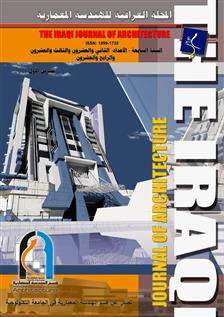The Impact of Technology on the patterns of the Arab-Islamic city
Abstract
The traditional Arab-Islamic city represented a reflection of the desires of the Arab-Muslim community and the Arab- Islamic character, and a clear expression of the religious and the cultural transformations of their different societies, and at the same time showed the physical structure formed by the characteristics of environmental and social principles and ideological, religious and spiritual values. The looking at the present Arab cities raise many fundamental and pressing questions regarding the continuity of the Arab- Islamic city in the present Arab societies. Is there still a real phenomenon of the "Arab-Islamic city", as active as the way it existed in the past, does this phenomenon have new patterns that reflect the Arab-Muslim community, or it was transformed by the challenges to a city that does not bear any pattern that reflect the patterns of the Arab-Islamic city?.That leads to the research problem (the impact of technological changes the transformation of the traditional Arab-Islamic city form, and modern and digital modern city form).The research contains an extensive study of the Arab-Islamic city, the modern Arab city and the digital modern Arab city and its patterns and the characteristics of its physical structure. Hence, three main indicators (indicator for land use, the physical fabric of the physical elements which includes the (mosque) indicator , markets, residential district and the streets net). Two examples were selected according to certain criteria that were adopted by the researcher, The first was Arab city, and Rusafa, the old city center of Baghdad, for implementing of the process of the practical study, finally to reach the results and the final conclusions and to identify the current patterns of the Arab city and the effects of the industrial revolution of the communications and information revolution on the Arab city.
The research contains recommendations for the urban designers; the most important is that the contemporary Arab city needs to have the characteristics that were aroused from the aspirations and requirements of the society and urban heritage within the situation and the stage. The research opens future perspectives for other researches to study the usage of the means of the industrial revolution and information technology and the ways of adapting these techniques in order to serve the Arab-Islamic city.
Downloads
You are free to use the work, but you have to attribute (refer to) the work in the manner specified by the author or licensor (but not in any way that suggests that they endorse you or your use of the work).
IRAQI J. ARCHIT & PLANN grants you the right to publish the metadata of the journal, it's issues and articles under the terms of the Creative Commons Attribution-ShareAlike 4.0 International License.
Author(s) hold the copyright of their aricles without restrictions. However, IRAQI J. ARCHIT & PLANN holds publishing rights for articles and their revisions once the article is published.
Authors can archive pre-prints (ie pre-refereeing) and post-prints (i.e. final draft post-refereeing) versions of the work they submitted to IRAQI J. ARCHIT & PLANN using non-for-profit open-access servers whether on author's personal website and/or institutional repositories including the university or research center where the author work.. For post-prints, only the IRAQI J. ARCHIT & PLANN’s as-published PDF version is permitted and the published source (IRAQI J. ARCHIT & PLANN’s website) must be clearly acknowledged within the archiving webpage.






